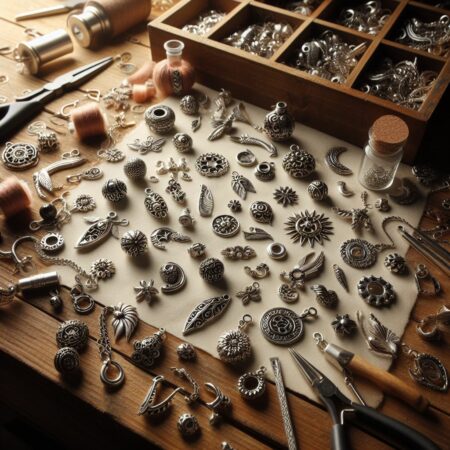The incredible beading world wouldn’t be complete if you didn’t know how bead threading works. Bead threading is a fine art, as much as beading and designing the jewelry or bead craft. Mastering bead threading can mean the difference between years of enjoyment and fulfillment with beading and fizzling out after a few months because you can’t expand creatively due to technical issues.
And for the rest of your jewelry-making needs, Xinar is your best online jewelry supplies store! Check out our varied collections of sterling silver charms, sterling silver beads, gold-filled beads, copper beads, rose-gold-filled beads, and more!
Before Bead Threading – Picking the Right Threads
If you only wish to string beads, you have several possibilities. You may also be interested in reading about stranded wire for crafting professional jewelry.
First, I would like to note that the best thread for bead jewelry projects is not necessarily the same as the best thread for bead weaving. These are two different activities. In the beginning, I’m sure many of you utilized bead weaving threads and have gotten good or moderately good results. For DIY home projects, this is an okay situation.
However, because this thread is so tiny, you will need to feed it through the beads many times to ensure that the necklace or bracelet is secure. This will not be the case if you employ a thread more suited for stringing beads. So if you want something more durable and secure for jewelry bead projects, you can check out the following brands.
Nymo, a parallel multifilament nylon thread initially designed for leather stitching, was one of the early and remained among the most popular bead-weaving threads. As a result, many beaders would not contemplate using anything else.
When I require a fragile thread, I often use a more acceptable size of Nymo. Available in sizes 000 (the thinnest) through 0 and A to FF (the largest). Made in 18 colors in B and D sizes. Frays quickly, making it undesirable for jobs requiring a very long thread (as in weaving, where the goal is to avoid adding thread often)
Silamide, a two-ply twisted nylon thread that has been used for bead weaving for decades, is a pre-waxed tailoring thread. Like Nymo, it has an entire user base. But, intriguingly, Nymo individuals tend to congregate on the East Coast, whereas Silamide enthusiasts tend to congregate on the West Coast.
C-Lon is parallel multifilament nylon explicitly developed for beading, and it
Illusion thread, commonly known as monofilament nylon fishing line, is the only transparent nonstretch beading thread, making it ideal for illusion or floating necklace designs.
PowerPro and FireLine are both high-tech fishing lines constructed from gel-spun polyethylene. Both are pre-waxed, durable, flexible, and possess a gentle hand. However, due to their strength, it might be difficult to cut these two threads using standard scissors, which prefer to eat them without cutting.
PowerPro is a braided material (similar in construction to plied or twisted thread made with four plies). Available in six weights ranging from.004 (5-pound test) to.011 (30-pound test). It is made using moss green, bright yellow, and white. Due to its spherical form, it may be more difficult to thread.
FireLine is likewise braided, but it is smoother and thinner, and I find it easier to thread than PowerPro. Offered in both smoky grey and crystal (translucent white).
Bead Threading Guidelines
What thread weight is ideal for beading?
There are no strict guidelines for selecting thread weights. The decision depends not only on the size of the holes in the beads you’re using but also on the weave you’re employing and the number of times you must pass through each bead. Consider the following:
- Use a rather big thread if you want the item to be firm.
- Use a waxed and doubled D-weight thread for weaving with 6° seed beads.
- Use a single strand of the same thread when weaving with 8° and 11° beads.
The thread choices of each beader are typically influenced by the sort of work they perform, the threads recommended by teachers and preferred books, and their prior experiences with threads.
New beading materials are constantly being introduced, so try the newest options to discover your favorites. It is usually best not to be blindly wedded to a particular thread brand. For one project, you may select a thread based on its durability, while for another, you may prioritize a precise color match.
Why do whole cones of Nymo threads look different?
The two threads are distinct, and there is a straightforward explanation. Nymo thread was developed in the sewing business and employed for leather stitching. A robust sewing machine uses the cone for the top thread and the bobbin for the bottom thread. These two threads are not identical for the proper formation of the machine stitch; the top one is heavier. Therefore, if you enjoy bobbins, continue to use them. Consider the cones or spools for a somewhat heavier weight.
Why can’t I build a necklace using the same thread as the beads?
Bead strands are often strung on cotton string or stiff nylon monofilament when sold. Both approaches are intended to be transitory. The cotton cord will rot and break over time, and the monofilament will not give your completed work a flowing drape. Both are intended to be replaced with superior materials when the time comes to do work. Flexible beading wire is the material for stringing products (necklaces and bracelets) nowadays.
On Using Bees Wax on Beading Threads
When is waxing the thread required?
Waxing your thread when weaving with beads is a question of personal choice. Some beaders constantly use wax, while others do it infrequently. However, I can assist you in making an informed choice.
Pros of waxing
- Aids in reducing thread tangling
- Strengthens the thread by coating it.
- It prevents fraying and cracking
- Produces a beaded fabric that is moderately stiff and shape-retaining.
- Assists the thread strands within each bead adhering to one another, resulting in reduced thread slippage and a tighter weave.
Cons of waxing
- Increases the diameter of the thread, allowing it to fill bead holes more rapidly. (Pay close attention if your pattern calls for many passes or advises against waxing for this reason.)
- It tends to make the thread somewhat soiled or attract dirt.
- It may clog the needle hole if used in excess. Before you begin sewing, you can iron the waxed thread between two pieces of absorbent brown paper. This is a couture stitching method, but it is too complicated for my beading.)
What’s the best beeswax for beading threads?
Pure beeswax for beading and stitching is typically offered as a tiny block or flat, round button. It is occasionally packaged in a plastic container to maintain cleanliness.
Many beaders prefer synthetic beeswax, offered in a tiny cup, over natural beeswax because it is softer, stickier, and distributes more uniformly than natural beeswax. As a result, the synthetic material rapidly became my preferred option for bead weaving when I tried it.
What is the difference between Thread Heaven and beeswax for thread treatment?
Thread Heaven is a thread conditioner with a synthetic composition meant to decrease static electricity and lubricate the thread to prevent tangling. It is wrapped in a blue box that will survive for many years.
Although Thread Heaven is applied to thread in the same manner as beeswax, it is less sticky than beeswax, so it does not pile up and clog your needle, nor does it aid in beading more firmly like beeswax.
In general, many crafters prefer beeswax over Thread Heaven, but several beaders like it. The product you select will depend on the sort of task you are performing. If you have issues with static electricity and tangling, try Thread Heaven.
Use natural or synthetic beeswax if you wish to work firmly, such as when bead-weaving a vessel or other construction that requires a perfect body to stand on its own. Utilize the resources that facilitate your success and lessen the obstacles you face.
How can I use these items to my thread to wax or condition it?
The objective is not to carve the thread into the wax but to coat the thread with a thin, uniform layer of wax. Here’s how to apply thread conditions:
1. Cut a length of thread that is manageable, which will be between 1 and 5 yards depending on the job and your degree of expertise.
2. Use your thumb to softly but firmly hold the thread length on the surface of the wax or thread conditioner.
3. Repeating three or four times with the other hand, draw the thread across the wax.
4. Turn the thread length and wax the opposite end as in steps 2 and 3.
Threading and Needles
What thread length should I work with?
The length is perfect as long as you’re comfortable with the length. Many crafters prefer to work with a lengthy thread, so I do not have to add thread frequently. Adding thread can be time-consuming, particularly when weaving closely on an elaborate item.
However, begin with a shorter thread if you are a beginner or if your thread tangles easily. This will give you additional practice making tight knots, and once you’ve gained some experience, you may progress to longer lengths of thread.
Novices typically begin with 1 yard of working thread plus as much they choose to leave as a tail (which may be used for adding a clasp or working an extra row later). Another option is to cut a 2- to a 2-and-a-half-yard piece of thread and place half of it in a tiny plastic bag. Start in the middle of your piece or design. When you’ve completed working with the first half of the thread, you immediately have a new thread ready to work the opposite way, without adding thread.
How can you unravel knots while beading?
There’s a method for untying knots that appears to work every time. First, notice that the sole distinction between a tangle and a knot is that a tangle becomes a knot when it is pushed tight. You may transform a knot into a tangle using two needles or pins.
1. Insert a needle into the knot’s center (avoid splitting the thread if possible).
2. Utilize the second needle to “tease” the knot, raise it, and loosen it.
3. Pull apart the strands of the loosened knot, and you’ll be left with a manageable tangle that you can undo with your fingers.
4. Apply more wax to the thread to prevent further tangling and continue beading.
Is it possible to thread Czech beads more easily?
Not only are you working with tiny beads, but the Czech beads also have microscopic holes. Therefore, this project requires a fine thread such as Nymo 0 and a needle of size 13.
If you encounter areas where the needle will not fit, such as when adding a new thread, temporarily swap to a size 15 needle. These needles are more costly, difficult to thread, and prone to breaking. Therefore, I recommend storing them for emergencies.
Surprisingly, the best shears for cutting them neatly are children’s-sized, dull Fiskars shears. Because they are challenging to cut, these threads are suitable for use with crystals, whose sharp edges may cut other threads.
They tie effortlessly, prevent fraying, have almost no elasticity, and are only available in a few colors.






